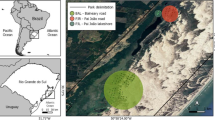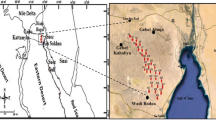Abstract
We investigated the influence of management and micro-scale landform on the species composition and richness of ground flora in secondary woodlands and their verges next to paddy fields in the Tama Hills, Tokyo, Japan. Sites representing various micro-scale landforms and different management regimes were sampled. The results of Detrended Correspondence Analysis and Indicator Species Analysis showed that there was no significant difference between management regimes on species composition in head hollow sites. However, species composition was unique in other landform types having the same management regimes. Micro-scale landform units had less effect on species composition than management regime on crest slopes and side slopes of secondary woodlands. A large variation in species composition of verges, all on the lowermost side slopes, was found within sites, but the composition was different when compared with other sites. We recognized five habitat types associated with species composition that resulted from the combined effects of landform and management regimes. Among habitat types, the verges and the well-managed woodlands had high species richness. Management practices within woodlands have enhanced the species richness on crest slopes and side slopes. High beta diversity of ground flora could be due to the variation in micro-scale landform along soil moisture regimes. Intensive management involving clear-cutting on the lower side slopes (an ecotone of mesic and wet environments) accompanied by paddy cultivation on valley bottoms enhanced the diversity of herbaceous vegetation in the verges.
Similar content being viewed by others
References
J.E. Ash J.P. Barkham (1976) ArticleTitleChanges and variability in the field layer of a coppiced woodland in Norfolk, England Journal of Ecology 64 697–712
J.P. Barkham (1992) The effects of coppicing and neglect on the performance of the perennial ground flora G.P. Buckley (Eds) Ecology and Management of Coppice Woodlands Chapman & Hall London 115–145
D.R. Bhuju M. Ohsawa (1998) ArticleTitleEffects of nature trails on ground vegetation and understory colonization of a patchy remnant forest in an urban domain Biological Conservation 85 123–135
D.R. Bhuju M. Ohsawa (1999) ArticleTitleSpecies dynamics and colonization patterns in an abandoned forest in an urban landscape Ecological Research 14 139–153
R.D. Brown M. Yokohari (2003) Ideological contribution of satoyamas K. Takeuchi R.D. Brown I. Washitani A. Tsunekawa M. Yokohari (Eds) Satoyama: The Traditional Rural Landscape of Japan Springer-Verlag TokyoJapan 1–7
B.R. Burns J.R. Leathwick (1996) ArticleTitleVegetation–environment relationships at Waipoua ForestNorthlandNew Zealand New Zealand Journal of Botany 34 79–92
C.M. Cowell (1993) ArticleTitleEnvironmental gradients in secondary forests of the Georgia PiedmontUSA Journal of Biogeography 20 199–207
P.M. Driessen (2001) Lecture Notes on the Major Soils of the World. World Soil Resources Reports 94 FAO RomeItaly
M. Dufrêne P. Legendre (1997) ArticleTitleSpecies assemblages and indicator species: the need for a flexible asymmetrical approach Ecological Monographs 67 345–366
T. Enoki H. Kawaguchi G. Iwatsubo (1996) ArticleTitleTopographic variations of soil properties and stand structure in a Pinus thunbergii plantation Ecological Research 11 299–309
K. Fukamachi H. Oku T. Nakashizuka (2001) ArticleTitleThe change of a satoyama landscape and its causality in KamiseyaKyoto PrefectureJapan between 1970 and 1995 Landscape Ecology 16 703–717
C.T. Garten SuffixJr. M.A. Huston C.A. Thoms (1994) ArticleTitleTopographic variation of soil nitrogen dynamics at Walker Branch WatershedTennessee Forest Science 40 497–512
H. Gondard F. Romane M. Grandjanny J. Li J. Aronson (2001) ArticleTitlePlant species diversity changes in abandoned chestnut (Castanea sativa) groves in southern France Biodiversity and Conservation 10 189–207
M. Hara K. Hirata M. Fujihara K. Oono (1996) ArticleTitleVegetation structure in relation to micro-landform in an evergreen broad-leaved forest on Amami Ohima Islandsouth-west Japan Ecological Research 11 325–337
J.F. Heltshe N.E. Forrester (1983) ArticleTitleEstimating species richness using the jackknife procedure Biometrics 39 1–12
M.O. Hill (1979) DECORANA: A FORTRAN Program for Detrended Correspondence Analysis and Reciprocal Averaging Cornell University Press IthacaNew York
M.O. Hill H.G. Gauch SuffixJr. (1980) ArticleTitleDetrended correspondence analysis: an improved ordination technique Vegetatio 42 47–58
T. Ichinose K. Katoh (1998) ArticleTitleFactors influencing bird distribution among isolated woodlots on a heterogeneous landscape in Saitama Pref., Japan Ekologia (Bratislava) 17 298–310
S. Iida T. Nakashizuka (1995) ArticleTitleForest fragmentation and its effect on species diversity in suburban coppice forests in Japan Forest Ecology and Management 73 197–210
Japan Meteorological Agency 2003. Monthly data in an average year (1983–2000) at Hachioji Meteorological Station (http://www. data.kishou.go.jp/).
T. Kikuchi (1990) ArticleTitleA DCA analysis of floristic variation of plant communities in relation to micro-landform variation in a hillside area Ecological Review 22 25–31
T. Kikuchi O. Miura (1993) ArticleTitleVegetation patterns in relation to micro-scale landforms in hilly land regions Vegetatio 106 147–154
Y. Kitagawa (2003) Regeneration of satoyama landscape K. Takeuchi R.D. Brown I. Washitani A. Tsunekawa M. Yokohari (Eds) Satoyama: The Traditional Rural Landscape of Japan Springer-Verlag TokyoJapan 129–142
T. Kitazawa M. Ohsawa (2002) ArticleTitlePatterns of species diversity in rural herbaceous communities under different management regimes, Chibacentral Japan Biological Conservation 104 239–249
V.J. Lieffers C. Messier K.J. Stadt F. Gendron P.G. Comeau (1999) ArticleTitlePredicting and managing light in the understory of boreal forests Canadian Journal of Forest Research 29 796–811
C.F. Mason S.M. Macdonald (2002) ArticleTitleResponses of ground flora to coppice management in an English woodland: a study using permanent quadrats Biodiversity and Conservation 11 1773–1789
B. McCune M.J. Mefford (1999) PC-ORD: Multivariate Analysis of Ecological DataVersion 4 MjM Software Design Gleneden BeachOregon
A. Miyawaki S. Okuda R. Mochizuki (1978) Handbook of Japanese Vegetation Shibundo TokyoJapan
D. Nagamatsu O. Miura (1997) ArticleTitleSoil disturbance regime in relation to micro-scale landforms and its effects on vegetation structure in a hilly area in Japan Plant Ecology 133 191–200
M.W. Palmer (1990) ArticleTitleThe estimation of species richness by extrapolation Ecology 71 1195–1198
M.R. Roberts F.S. Gilliam (1995) ArticleTitlePatterns and mechanisms of plant diversity in forested ecosystems: implications for forest management Ecological Applications 5 969–977
A. Rubio R. Gavilán A. Escudero (1999) ArticleTitleAre soil characteristics and understorey composition controlled by forest management? Forest Ecology and Management 113 191–200
A. Sakai M. Ohsawa (1993) ArticleTitleVegetation pattern and microtopography on a landslide scar of Mt. Kiyosumicentral Japan Ecological Research 8 47–56
C.J Small B.C. McCarthy (2002) ArticleTitleSpatial and temporal variability of herbaceous vegetation in an eastern deciduous forest Plant Ecology 164 37–48
F.J. Swanson T.K. Kratz N. Caine R.G. Woodmansee (1988) ArticleTitleLandform effects on ecosystem patterns and processes BioScience 38 92–98
S. Takano (1994) ArticleTitleStratigraphy of the Lower Pleistocene Kazusa Group in the Tama Hills, central Japan Journal of Geological Society of Japan. 100 675–691
K. Takeuchi (2001) ArticleTitleNature conservation strategies for the ‘satoyama’and ‘satotiȁ9, habitats for secondary nature in Japan Global Environmental Research 5 193–198
K. Takeuchi M. Ide M. Yokohari R.D. Brown (1995) ArticleTitleRelationships of landform and biological diversity in landscape ecology Trans. Japanese Geomorphological Union 16 215–225
T. Tamura (1974) ArticleTitleMicro-landform units composing a valley-head area and their geomorphic significance Tohoku Chiri 26 189–199
T. Tamura (1981) ArticleTitleMultiscale landform classification study in the hills of Japan: II Application of the multiscale landform classification system to pure geomorphological studies of the hills of Japan Sci. Rep. Tohoku Univ. 31 85–154
T. Tamura K. Takeuchi (1980) ArticleTitleLand characteristics of the hills and their modification by man: with special reference to a few cases in the Tama Hills, west of Tokyo Geographical Reports of Tokyo Metropolitan University 14 IssueID15 49–94
I. Washitani (2001) ArticleTitleTraditional sustainable ecosystem ‘satoyama’and biodiversity crisis in Japan: conservation ecological perspective Global Environmental Research 5 119–133
N. Yoshida M. Ohsawa (1996) ArticleTitleDifferentiation and maintenance of topo-community patterns with reference to regeneration dynamics in mixed cool temperate forests in the Chichibu Mountains, central Japan Ecological Research 11 351–362
Author information
Authors and Affiliations
Corresponding author
Rights and permissions
About this article
Cite this article
Okubo, S., Kamiyama, A., Kitagawa, Y. et al. Management and micro-scale landform determine the ground flora of secondary woodlands and their verges in the Tama Hills of Tokyo, Japan. Biodivers Conserv 14, 2137–2157 (2005). https://doi.org/10.1007/s10531-004-4362-0
Received:
Accepted:
Issue Date:
DOI: https://doi.org/10.1007/s10531-004-4362-0




